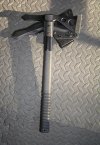- Joined
- Mar 24, 2001
- Messages
- 8,326
I've had an opportunity to put a fusion through its paces. Great hawk. Inexpensive, great gripping surface, great construction, excellent for weapon on weapon, due to the head construction that has a metal collar with an exposed slanted surface to the head, and a great weight.
The negatives are the sheath, but I've yet to see a decent sheath for any axe out there.
I'd carry this in a second as a fighting hawk. Indeed, I think this exceeds any of the hawks on the market. Good for SOG.

The negatives are the sheath, but I've yet to see a decent sheath for any axe out there.
I'd carry this in a second as a fighting hawk. Indeed, I think this exceeds any of the hawks on the market. Good for SOG.

